Holloway Protest - Release the Yarl's Wood Three!
Holloway Prison, London. Friday 31 Dec 2010
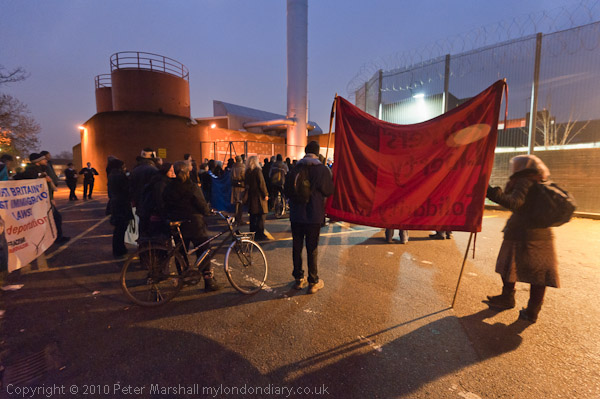
When the protesters made a noise at the back of the
prison, women inside shouted support
more pictures
Around a hundred protesters gathered at Holloway prison and called noisily for the release of the 3 asylum detainees jailed without charge or trial following a hunger strike at Yarl's Wood last February.
The three women, Denise McNeil, Sheree Wilson and Aminata Camara were among more than 60 women who began the hunger strike at Yarl's Wood detention centre on Feb 5, in a protest against their detention and the conditions under which they were held. Some had already been detained for long periods and their have been many complaints about the poor conditions, lack of proper food and maltreatment, as well as the failure to give proper access to legal advice and health care. The centre is run by the private company, SERCO for the UK Borders Agency.
During the hunger strike some of the women were locked in a hallway for and extended period and some were also held out of doors in cold weather without outdoor clothing. The hunger strike ended around 21 March when those still taking part suspended the protest fearing that their health might be permanently damaged.
Over 70% of the women held in the centre are thought to be rape survivors. Many held there in the past have been subjected to arbitrary removal back to their country of origin before their cases have been properly considered.
Denise McNeill came from Jamaica and has lived in the UK for more than ten years, and has two children, aged 8 and 17 living here. In September 2008 she was arrested for possession of cannabis for personal use, for which she was given a six month prison sentence, and on release whe was taken into detention with the intention of deporting her. She was due to be flown back to Jamaica in September but this was cancelled on the day she was due to be flown back.
Denise's brother was earlier forcibly removed from the UK to Jamaica, despite his protestations about the dangers he would face. He was killed there in March 2010, and Denise's sister and cousin have also been killed in gang feuds there. Denise fears a similar fate if she is deported. She came to this country for refuge from this and after suffering 13 years of domestic abuse.
During the hunger strike she was in the group locked in a corridor for six hours without any facilities when the guards tried to stop the protest forcibly. She was then beaten by the guarsds, according the reports in The Guardian being "assaulted repeatedly and violently assaulted by a [named] officer, on one occasion so violently that she lost consciousness". Later, staff allegedly kicked her in a leg, badly injured when she was a child by gangland crossfire. She was kept in solitary for four weeks and then moved to Holloway. Her main "crime" appears to be that she talked to The Guardian on several occasions from Yarl's Wood - and she was moved to prison so she no longer had access to mobile phones.
Sheree Wilson, also from Jamaica is also being held in Holloway, while Aminata Camara from Guinea is in HMP Bronzefield in Ashford, Middlesex. While UK citizens can only be remanded in prison after having been brought before a judge, these women were detained on the order of Minister of State for Borders and Immigration Phil Woolas MP.
Today's protest was organised through a Facebook group supporting the 'Free Denise Now' campaign organised by the National Coalition of Anti-Deportation Campaigns (NCADC).
After a noisy protest on the main road in front of the prison, the hundred or so protesters marched around the side of the prison through the car park to a rear entrance where they held a short rally and made a lot of noise so that the women inside would hear them.
A small group of police came and asked the protesters to go back to the main road in front of the prison and continue their protest on the road, but the protesters decided to stay for some minutes to show their solidarity with the women inside, who were clearly able to hear the protest. Several women could be heard shouting back from inside the prison with one voice - perhaps Denise's - shouting "Get me out of here!" loudly and repeatedly.
After a few minutes, the handful of police retreated to their van on the main road and sat there, and eventually the protesters rejoined them there - at which point they drove away.
Later the protesters marched round to the back of the prison again to make sure their protest was heard by the prisoners. After a while I had to leave them, around 20 minutes before the two hour protest was due to finish.
Denise McNeil has a bail hearing at Richmond Magistrates Court, Parkshot,
Richmond on Tues 4 Jan 2011 from 10 am, where there will be a further demonstration.
At previous hearings the protesters say that the Government lawyers made racist
and discriminatory arguments to keep her locked up. They hope to stop this
happening on Tuesday.
more pictures
London Vigil For Gaza
Israeli Embassy, Kensington High Street, London. Mon 27 Dec 2010
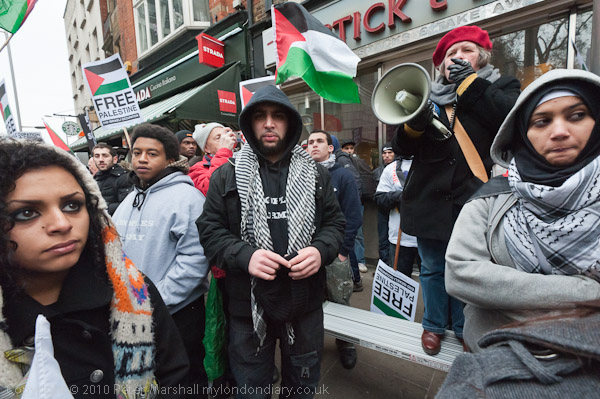
Lindsey German speaks at the rally opposite the Israeli
embassy
more pictures
Exactly two years after the start of the Israeli attack on Gaza, protesters gathered for a vigil outside the Israeli Embassy calling for an end to the siege on Gaza. 'Operation Cast Lead', Israel's war against Gaza, began on 27 Dec 2008. By the time this illegal attack came to an end on 18 Jan 2009, it had killed more than 1400 Palestinians and devastated the Gaza strip, destroying homes and infrastructure.
Israel's continuing blockade of Gaza prevents the import of building materials and other essentials. Many of the families whose homes were destroyed are still living in tents and even the UN has been unable to rebuild its shattered schools.
The protests was organised by a large number of groups - the Palestine Solidarity Campaign, Campaign for Nuclear Disarmament, Stop the War Coalition, British Muslim Initiative, Friends of Al Aqsa, Palestinian Forum in Britain, Viva Palestina, Palestinian Return Centre, War on Want, Russell Tribunal on Palestine, Amos Trust, The Green Party, Friends of Lebanon, Public and Commercial Services union, and the Israeli Committee Against House Demolitions UK (ICAHD UK.)
ICAHD UK supports the activities of the Jerusalem-based ICAHD, founded in 1997 by a group of peace activists in Israel with the aim of ending the occupation and achieving a just peace between Israel and Palestine and in particular to work by non-violent direct action to end the Israeli policy of demolishing Palestinian homes in the Occupied Territories.
A densely packed crowd of around 700 people assembled in and around the barriers the police had erected opposite the Israeli embassy at 1pm. Among them were many Palestinians including a large number of young men and women, as well as supporters from the various organising groups and others.
Among the speakers were a trade unionist who encouraged the crowd with the news that the demonstrations in London against the Israeli occupation were having a significant effect across the world and urged them to keep up their efforts, and Lindsay German of Stop the War. There were also a few short speeches by young Palestinians and others, and one man performed a short rap, but much of the time was taken up by chants calling for a free Palestine "from the river to the sea".
Many of the strongest supporters of the Palestinian cause in the UK are Jewish, and among the banners was one for J-BIG, a Jewish group calling for a Boycott of Israeli goods. There were also a number of men from the ultra-orthodox Neturei Karta, anti-Zionist Jews who regard the Zionism and the state of Israel as being against the Torah.
Although most Palestinians are Muslim, Palestine is also the 'Holy Land' for Christians as well as for Jews and the events around two thousand years are celebrated in churches across the land at Christmas. One woman had brought some updated versions of such carols as 'O Little Town of Bethlehem' with words that reflected the current conflicts in the area.
O little town of Bethlehem
Imprisoned how you lie.
Above thy deep and silent grief,
Surveillance drones now fly.And through thy old streets windeth,
A huge illegal Wall.
The hopes and dreams of peace, it seems
Are dashed, in pieces fall.
and
Away and in danger, no roof over head,
Their homes were destroyed in Operation Cast Lead,
The bombs in the bright sky, rained down where they lay,
And for three hundred children ‘twas their very last day.
Quite a few of those present were unhappy at the idea of people singing carols - even these secularised versions - but after she had sung one powerfully through the megaphone I think they were mollified. Bethlehem is now a virtual prison for its Palestinian Christian and Muslim citizens, with just 3 gates controlled by Israeli soldiers, and most of its land where once "shepherds watched their flocks" confiscated for illegal Jewish settlements.
The peaceful vigil stayed on the busy Kensington High Road for two hours,
with traffic control lights for nearby road works making traffic wait alongside
the protest and then move slowly by in one direction at a time. Many bus passengers
waved and motorists beeped to show their approval for the protest.
more pictures
Boxing Day Thames Walk
Staines to Old Windsor. Sunday 26 Dec 2010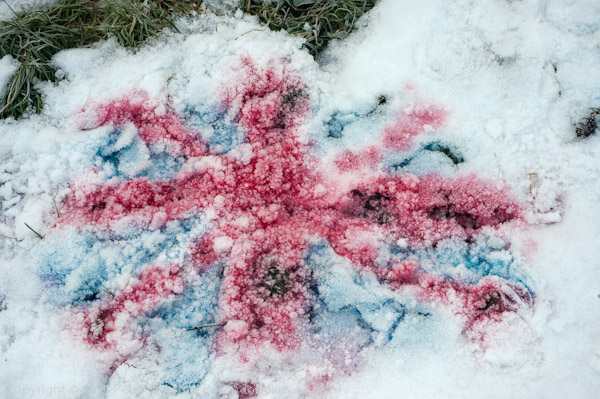
Patriotic snow at Staines
more pictures
Boxing Day for me is the day after Christmas, and I wasn't going to change my mind just because we had Christmas on a Saturday this year. Getting to places poses a slight problem at times for us at Christmas as we normally rely on public transport, and the railways take a holiday. There are at least theoretically buses running, but here just outside Greater London the service is dire at the best of times and on Sundays it's usually quicker to walk anywhere. Normally I'd get on my bike, but we had our elder son with us and he doesn't like to ride my spare bike, apart from which I like to have the odd glass of wine, and cycling home on our local racetrack roads in the dark after that is probably not a great idea. So as usual on one of the days of Christmas we walked to my sister's house to have lunch there; fortunately we can do most of it along the towpath beside the River Thames.
This year there was still a decent covering of snow, although by now this
was well trodden down in places, and getting up and down the few slopes on
the route was hazardous.
more pictures
Derbyshire Walks
Belper, Derbyshire. Sunday & Monday 19-20 December 20
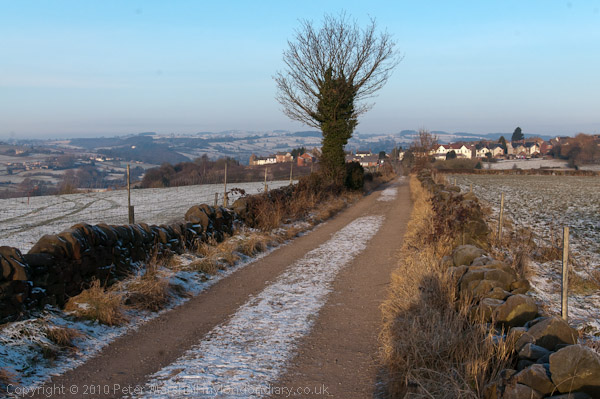
A lane near Belper
more pictures
Snow was falling and already deep in Staines when we left home, and the radio was issuing dire warnings against travel, but we checked on the web and trains seemed to be running normally to Derby and Belper. On our way we were visiting a friend in Streatham, and we walked through some fairly deep snow on Tooting Bec Common, but the main roads were still clear and our 59 bus to St Pancras ran if anything slightly faster than usual as there was less traffic.
At St Pancras, although there were many cancellations on the suburban services, our train to Derby came in and went out only a few minutes late. We arrived at Derby a minute after the connection to Belper - the last train for the night was timed to leave, but fortunately they had the sense to hold the connection.
There was virtually no snow in Derby or Belper, just a slight sprinkling
that could have just been frost. We'd come to visit my son and his family
(family can e-mail me for the link to those pictures) but on Sunday morning
we went for a longish walk, and again on Monday in the early afternoon before
we caught the train home. This time the Belper train was a few minutes late
but we still just arrived in time to connect with the London service, and,
despite the repeated warnings about not travelling, actually arrived at St
Pancras a minute or two early. Our train back to Staines was running to a
special slow "snow timetable" (it helps the company avoid having
to pay compensation) with a reduced service, and between Clapham Junction
and Putney it reached almost Japanese standards of overcrowding. Certainly
not enough room to get out a camera and take pictures, so all you see here
is from our two walks around Belper and the surrounding area.
more pictures
Housing Emergency Protest
Downing St, Whitehall, London. Wed 15 Dec 2010
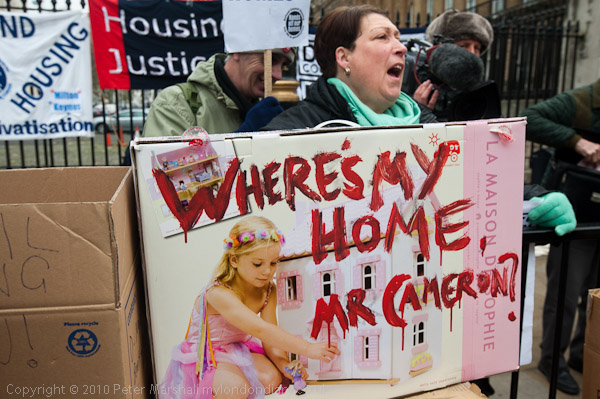
'Where's My Home Mr Cameron?'
more pictures
Organisations and individuals shocked at government proposals over tenancies, rents and housing benefit lobbied MPs and demonstrated outside Downing St.
The lobby and demonstration was organised by 'Housing Emergency', which brings together individuals and organistions including the House of Commons Council Housing Group, Defend Council Housing, Unite, GMB and PCS trade unions, several local councils and tenants organisations, London Coalition Against Poverty, Right to Work Campaign, Labour Representation Committee, Disabled People Against Cuts and the National Tenants Council.
The government's proposals are an attack on secure tenancies with new tenants being offered fixed term tenancies, and most of the 5 million on housing waiting lists will be unable to afford the new homes being built which will be offered at up to 80% of the market rent. Capping the amount of housing benefit will lead to many tenants becoming unable to afford to stay in high rent areas, particularly much of London and the South-East.
Speakers said that the proposals will lead to many currently socially mixed areas of London becoming "ghettoes for the rich" which people on middle or low incomes - including most public sector workers - as well as those such as the disabled who rely on benefits being unable to afford to remain there. They say that the way to combat high rents is to introduce rent caps rather than to attack tenatns, and that we need to build more social housing and provide security of tenure to create and sustain diverse and thriving communities.
Among those who spoke at the rally opposite Downing St where campaigners
created a 'cardboard city' were MPs Kevin Hopkins (Labour Luton North)
and Austin Mitchell (Labour Great Grimsby.)
more pictures
A Thousand Cancuns for Climate Justice
Brixton Oval, Brixton, London. Sunday 12 Dec 2010
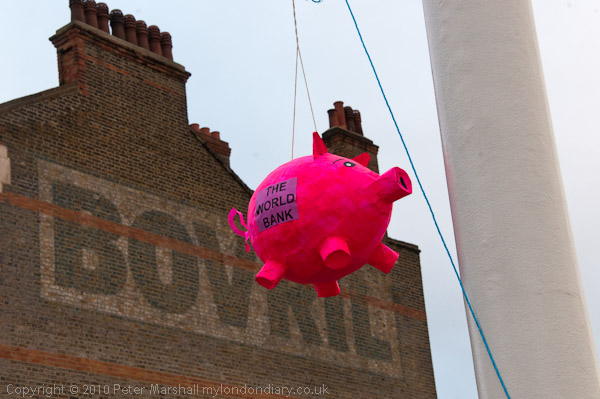
A pink pig piñata full of chocolate coins stood for the World
Bank
more pictures
Brixton responded to the world-wide call by global peasants organisation La
Via Campesina for 'Thousands of Cancuns for Climate Justice' to
mobilise grass roots solutions and actions. It was a small gathering that took
place at Brixton Oval on a chilly winter afternoon, with an exhibition including
posters from the Heathrow Climate Camp, several based on the book Six Degrees:
Our Future on a Hotter Planet by Mark Lynas and a poster produced
by the local climate justice group group illustrating the global links between
the war in Iraq, rainwater contaminated by Texaco/Chevron in the Amazon rainforest
in Ecuador and a petrol station in Brixton displayed on the railing around the
disused public toilets, unfortunately not restored in the recent bare, open
and soulless refurbishment of the Oval and Windrush Square.
The call came following the Cochambamba People's summit for climate justice held in April this year, a much larger event than Cancun, with around 40,000 people from around the world attending. The 'Cochabamba People's Agreement' which came from this was brought to Cancun by the Bolivian government, but its concrete proposals were rejected in favour of an agreement which accepted the empty gestures of the wealthy nations and gave them new loopholes to avoid effective action.
The Brixton event was one of roughly 70 around the world but was the only one listed for the UK. One of the speakers had attended the Cochambamba summit and told us about her experiences there. Other speakers included one from the World Development Movement and a speaker from the Global Women's Strike. She emphasised the pivotal role of women in much of the world's economy and the need for this to be taken into account in developing appropriate solutions to social injustice.
We need urgent action to halt global temperature rise, but it must be action that is globally and socially just. Rather than favour the rich, it must take into account the needs and preservation of the poor of the world, most of whom live in the areas at highest risk from global warming - and which on current trends will inevitably become uninhabitable in the mid-term future.
La Via Campesina is "an international movement which coordinates peasant organizations of small and middle-scale producers, agricultural workers, rural women, and indigenous communities from Asia, Africa, America, and Europe" and it has represents almost 150 organisations in with a total of 150 million members across 69 countries. It advocates sustainable local agriculture in opposition to the international market led approach of the rich countries and their international instututions. Their key idea is that of food sovereignty - the right of people to an appropriate healthy diet, underpinned by the return of land to those who work on it, the protection of natural resources including the soil, regulation of the trade in food with policies that prioritise local production and self-sufficiency rather than profit, as well as democratisation and an end to repression.
Brixton has a long history of direct action against social and structural injustice, stretching back more than 200 years to the anti-slavery campaign and continuing to the present day. The event was designed to link these local struggles "to global issues of climate justice; including the pillage of natural resources, environmental racism, disasters caused by climate change, growing inequity, discrimination, marginalization of the poor and a new age of austerity to pay for the banker’s bailout."
The event ended as darkness fell with a short and rather tough quiz on global climate issues to decide who should be allowed to bas the 'Bash the Bankers piñata', a pink pig labelled 'THE WORLD BANK' that had been flying above the event all afternoon. Unlike in the real world that led to all of us being able to share the 'cash' which it contained which showered down as chocolate coins.
Many of the 25 or so people who were present at the end - others had drifted
across during the afternoon to view the posters, pick up information about
the group and listen to some of the speeches - took up the invitation to continue
the event inside at a local pub, but I had other things to do.
more pictures
ENA March through London
St Anne's Gate - Waterloo Place. 11 Dec 2010
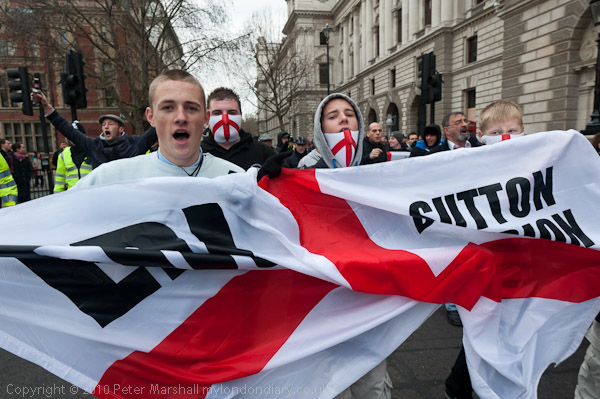
Sutton Division of the EDL on the march
more pictures
Around 50 members of the English Nationalist Alliance held a peaceful march through London today, delivering a letter to Downing St calling for an end to Sharia law in the UK. Although organisers and police had expected a larger march there were only just over 40 members of the English Nationalist Alliance at the start of today's march, held at the same time as an EDL demonstration in Peterborough.
The purpose of the march was to deliver a third letter to prime minister David Cameron asking for him to honour his promise made before the election that Sharia law courts in UK mosques were not acceptable and would be dealt with as a "priority once the Conservatives took power." Two previous marches, in May and July had delivered letters asking for action and had received what the organisers regarded as "very unsatisfactory replies" and no action has been taken by the government.
The letter from the ENA, representing the English Defence League, Shield Wall, The British Society for Freedom of Speech, Christians for Democracy, England United (Weiran Ce Angelcynn). England St George, Acacia Freedom Fighters, Sikhs Against Sharia, English Jewish League and Parents Against Sharia, mentions the recent student demonstrations and states: "This is a Government under siege. You have failed to listed to listen to the people that voted in your favour.... The thing that has the people needled is that votes were gained under false pretences."
The ENA go on to make clear that they "want a single English legislative system that is, irrespective of race, religion, colour, culture or sexual preferences, inclusive." They say that "all civil and criminal matters should be solely supervised by the State under existing Civil, Criminal and Statute Laws" and that "nothing should be allowed to subvert these laws that are founded in England and have grown out of many years of civilised debate and development."
They also had other demands, both in the letter and on the banner at the front of the march, which after its first point "No Sharia Law" went on to list:
"Deport Foreign Criminals
Withdraw from the EU
Parliament for the English
Immigrants pay their way."
As the march formed up in Queen Anne's Gate, a small group of young EDL supporters started an anti-Muslim chant and were immediately stopped by the ENA organiser, Bill Baker, who told them there was to be none of that sort of behaviour at the event as the ENA was not against Muslims, but only against extremists. The ENA insists it is not racist and that it welcomes English patriots from all communities, and although the marchers were predominantly white, British and male, there were clearly some exceptions as you can see from the pictures.
The march set out at a fast walking pace, going through Parliament Square and into Parliament Street where it was applauded by a group for March For England supporters, standing with several flags on the edge of the pavement outside the Red Lion. They had earlier been giving their support to Falklands veterans laying wreaths at the Cenotaph.
The ENA passed the Cenotaph in silence, and then broke into clapping before stopping in the centre of the road opposite Downing Street, where the letter was to be delivered. Bill Baker spoke briefly to the group, telling them the contents of the letter, before the march moved on.
The march finished in Waterloo Place, were there were a couple of short speeches. Stephen Green, National Director of Christian Voice talked about the state of the nation and in particular about his group's opposition to the plans for a 'mega-mosque' in West Ham, which he said their efforts had prevented.
The mosque site, formerly a chemical works, has been owned by the conservative Islamic Tablighi Jamaat since 1996, and they had permission to use the existing buildings on the site as a place of worship for five years from 2001. As well as the campaign led by some right-wing Christian groups, the plans for a mosque were also opposed by some prominent Muslim groups. The scale of the proposed mosque has been greatly exaggerated in many of the reports which are largely based on a proposal turned down by the site owners, and the failure of them to make any planning application is almost certainly due to their inability to find sufficient funding - which they insist must come mainly from donations from Muslims in the London area.
The rally ended with a speech from Sareeta Webra, an English Sikh and the organiser of a Facebook group 'Sikhs Against Sharia', about the dangers of Sharia law.
Although there had been at least one call for supporters of 'Unite Against
Fascism' to meet and oppose the ENA march, I saw no evidence of any opposition
to it along the route. It does not seem to have been mentioned on the UAF
web site. UAF supporters also were busy in Peterborough today, with a rally
and action opposing the EDL, as well as protesting at the BNP conference in
Leicester and holding a conference in London.
more pictures
Students Against Cuts - Day 3
London. Thursday 9 Dec 2010
 A
student jumps up in the smoke from an orange flare in Parliament Square
A
student jumps up in the smoke from an orange flare in Parliament Square
more pictures
Thousands of students and sympathisers marched in London today to Parliament Square and occupied it while the House of Commons debated the fees rise and the official rally took place a short distance away. Police clashed with protesters, and protesters and press suffered minor injuries.
On the day the Parliament was voting for a three-fold increase in university tuition fees, students filled the main streets of Whitehall in a noisy and at times indisciplined protest. Police actions stirred up antagonism, and there were a number of charges in which protesters and press suffered minor injuries as riot police used their batons and police horses also made a short charge into the crowd.
Some of the injuries appeared to be caused by 'rogue' officers and several press photographers told me that had been been very clearly targeted by individuals, with several of my colleagues having their equipment deliberately smashed by police. Fortunately for my safety I had left to photograph the small official rally on the Embankment minutes before the worst violence flared up, although I was threatened by both riot police and mounted officers during the events.
Although students are angry, and rightly so at the increase in fees, the removal of the education maintenance allowance and swingeing cuts in some courses, particularly in the arts and humanities which are to lose 80% of their funding, the overall mood of the protest was good-natured if exuberant. At one point late in the day when a few fireworks were thrown into the police lines opposite the Houses of Parliament, the packed crowd dancing at the front turned towards those throwing them and told them told them over the sound system that the police were only doing their job and that they too would suffer from the cuts, and the crowd of dancers began to chant against those who had thrown the fireworks.
I began the day with the ten or twenty thousand - I never managed to see the back of the march - who were marching from the University of London in Malet St, many of them school sixth-formers who will be among the first to be affected by the fees rise and cuts. There were speeches from John McDonnell MP and several trade unionists as well as student leaders, but two sixth formers from occupied schools got the biggest and truly deafening welcome from the crowd. But most there were keen to get on and make their protest, and for most the rally was over-long.
Once the march, organised along 'Stop the War' lines with a large block of stewards at the front, had started, many were impatient with its slow pace, and on Kingsway, several hundred protesters pushed their way past the stewards and ran ahead down the street, already cleared for the march.
Police formed lines across the road to stop them, but these were soon swept aside, and only served to reinforce the conviction of the protesters that the police were out to stop and kettle them. At Aldwych, these protesters saw police at the junction ahead, blocking Waterloo Bridge, and reacted with kettle paranoia, rushing up a side street towards Covent Garden, while the official march continued without obstruction along the agreed route along the Strand.
At this point it seemed clear that both police and some of the protesters were clearly guilty of over-reacting, and it set the scene for the day. It would surely help if the police were clearer about their intentions and in communicating these to the mass of demonstrators, perhaps using a powerful public address system.
Trafalgar Square and the road junction to its south were packed with demonstrators when the official march arrived, and those waiting there immediately began to continue as the new head of the march along the agreed route through Admiralty Arch and down Horseguards Road.
Once we had reached Parliament Square it was clear that whatever the official organisers had planned, most of the protesters wanted to continue their protest there. Only a small dribble continued up the agreed route into Whitehall (and rumours again spread that the march was being kettled) but most were simply determined not to move away from the Houses of Parliament where the debate was taking place. This came as no surprise to most of us covering the protest and there might have been fewer problems and much less damage had the authorities planned with the organisers for the final rally to take place there rather than elsewhere.
Apparently a few of the students did manage to make their way through the police lines to lobby their MPs, but others told me that they had been refused permission to do so.
People began milling around the square, and some started to light small fires with placards and waste paper. Police had sealed off all exits from the square except Whitehall, and in the south-east corner, a group of more than a thousand students had gathered, with a hundred or so making an attempt to push through the line of riot police towards Parliament and the rest watching what was happening.
I spent a few minutes trying to take pictures and getting very squashed before deciding I needed to push my way out for my own safety, both from the police and from being crushed in the crowd. A few minutes earlier I had been in the front line and being crushed by the crowd against the barriers in front of the riot police, and I and the others around me were repeatedly threatened by riot police shaking batons at us and telling us they would attack us if we didn't move back - which was simply not possible - we were totally unable to move due to the pressure of the crowd.
By this time much of the flimsy temporary fencing around Parliament Square had been overturned and the central area of the square, now mainly covered in lush over-long grass after having been fenced off in July, occupied. There were groups dancing around radios and sound systems, playing guitars and mouth organs, a few warming themselves around small fires and otherwise keeping up their spirits.
I decided it was time to go and see what was happening at the official demonstration and walked up Whitehall and down past the Defence Ministry to the Embankment. There was a line of police across Whitehall at this time but they were allowing people to walk through freely in both directions. The rally had not started when I arrived as there were so few people present - many who had gone there and found nothing happening passed me on their way back to Parliament Square.
Finally, after some angry shouting from people telling the organisers to stop playing music and get on with it there were speeches from union leaders - including Brendan Barber and Bob Crow, who got a big welcome - and politicians.
The crowd had built up a little to perhaps 500 or a thousand people, when someone arrived and shouted that police had attacked the demonstrators in Parliament Square, charging with police horses, and I joined a number of others in trying to make my way there. Police were only allowing the press through, so a small demonstration had developed in front of their line on Westminster Brdige, but I was able to make my way to Parliament Square again. By now it was getting dark, and there were many more fires as well as larger groups of dancers.
Suddenly there were some dramatic flames and a large cloud of black smoke and I hurried towards them. A plastic security hut which had earlier been turned on its side was now in flames, with a large group of people around it taking photographs.
Next I went up Whitehall, having heard a few minutes earlier a police officer telling students that they could still leave the area that way. It was no longer true, and I was pushed back by police with riot shields who were not at all interested in my press card (one TV camera crew did manage to push their way past.) Behind them were a line of police horses, and everyone in Whitehall was pushed back to a line of police vans in Parliament Street. The police around these were still more relaxed, although again a line of riot police standing at ease refused to let me through, directing me to their boss. I listened to him arguing with a group of students that they were not being detained although they were not being allowed to leave. It's a legalistic argument that destroys the relationship between people and police that is essential for the cooperation that the police need to do their job which is why kettling is so corrosive a tactic. I then realised that just a few yards to the right, presumably under the control of another officer, people were walking freely through - so I did, back into Parliament Square. At the next police line I again showed my card and was allowed through without problems, finally walking out through a further line that was stopping people entering the area, and was able to make my way elsewhere.
Protesters were being kettled, detained in Parliament Square after the vote had taken place, when many of them wished for nothing more than to be allowed to go home peacefully. I heard later that there were further violent incidents and arrests. Police at one point apparently pushed a large group into a very confined space on Westminster Bridge with a total disregard for their safety; some had to behave medical treatment for crushing, and there could easily have been more serious or fatal injuries and people pushed into the freezing river below.
It was a day of confusion, with protesters and police both failing to understand
what was happening, and an official student leadership that fails to understand
the mood and anger of the students and others - and although the RMT and Bill
Crow had offered support, the TUC has curiously failed to take action, putting
off its march against the cuts until March.
more pictures
March for Zero Carbon Britain 2030
Hyde Park to Westminster, London. Saturday 4 Dec 2010
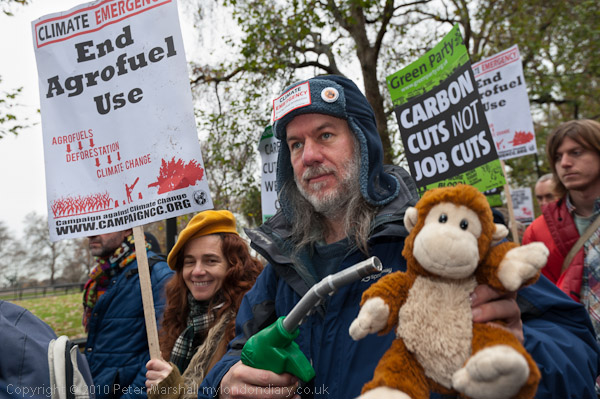
End Agrofuel Use - man with petrol hose and monkey on march
more pictures
Several thousand took part in the Campaign Against Climate Change march to Parliament calling for urgent action over climate change including a Zero Carbon Britain by 2030. The march and rally was the seventh annual climate march organised by the CACC, which has spearheaded the campaign to get effective action to meet the climate challenge since its formation, aiming to put climate change at the top of our political agenda as the greatest threat that humanity faces.
Held in December each year, this year it marked the midpoint of the crucial Cancun climate talks now taking place; last year's larger event coincided with the climate talks at Copenhagen. Some of the major charities that took part in last year's event were notable by their absence, and the Climate Coalition which was then active appears to have disappeared from active campaigning. Among the groups which did take part were Friends of the Eath, Greenpeace, the World Development Movement, the Climate Rush, the Green Party and others including many local groups, trade union branches etc.
Several thousand gathered in a rather chilly Hyde Park for a photograph before the march. Some of those who might have attended were unable to make as the country was still experiencing transport chaos after the recent snowfalls, a cold snap which was a reminder of the less predictable global weather due to global warming, and is thought to be a consequence of Arctic warming.
I became a part of an aerial photograph being taken from a cherry-picker, spelling out the demand for a zero carbon Britain, taking care to keep among the people on the marked lines while I photographed some of them standing there and waving at the photographer above. I was glad I wasn't up there taking pictures as I don't have a great head for heights, and it looked very chilly.
The march then gathered on the roadway at the north of the park before making its way down Park Lane and Piccadilly and then on to Whitehall. I left it a little before Piccadilly Circus to go elsewhere, returning to catch it up around half an hour later as it came along Parliament St and into Parliament Square.
As Parliament Square is still fenced off, the rally after the march was held a short way past it in Millbank, and marchers were greeted as they arrived by the sounds of 'Seize the Day', the great "radical English acoustic band with global roots" which has enlivened many major festivals and protests around the world.
The Campaign Against Climate Change (CACC) has continued to press for action, and this march in particular called for the UK to become a zero carbon economy by 2030. Much of it was based on an in-depth report compiled for the Centre for Alternative Technology (CAT), 'Zero Carbon Britain 2030: A new energy strategy', which was published in June and can be downloaded from their web site at no charge or purchased as a printed copy.
As Paul Allen of CAT said:
"The cuts we really should be talking about are the cuts in carbon emission - we cannot bail out the climate in the same way that we have bailed out the economy. We only have one chance."
Among the other speakers at the rally on Millbank, were Phil Thornhill, founder of the CACC, Caroline Lucas MP, Andy Atkins, Director of Friends of the Earth, Michael Meacher MP, Sophie Allain from the Climate Camp who was one of the Ratcliffe 20 charged with plotting to shut down one of our highly polluting coal-fired power stations (charges against her were dropped, but others are currently on trial) and Maria Souviron, the Ambassador of Bolivia, one of the few nations to have grasped the urgency of climate change and a leader in the call for effective world action. I left before the end of the rally, and other speakers expected included Tony Kearns of the CWU, Ben Brangwyn, co-founder of the Transition Towns movement, Maryla Hart from Biofuelwatch and John Stewart of HACAN.
Several speakers stressed that the UK had been in the lead in the industrial revolution that had eventually lead to our current climate problems, and pointed out the opportunity we were in danger of missing to lead a new green revolution, which would provide many green jobs here.
As well as calling for a commitment by the government to work towards a zero carbon Britain by 2030 and to create a million green jobs now, CACC called for a 10% cut in carbon emissions by the end of this year. The government must ensure that we get actual cuts rather than 'carbon offsets' or other schemes that don't result in real reductions in emissions and must stop basing their energy policy on the lobbying of the energy industry. Investment in green jobs would also give the economy a much needed boost.
Although the UK has huge renewable energy resources, with, for example more potential for wind energy that the rest of Europe combined, we are lagging well behind other European countries such as France, Germany and Scandinavia, producing a pathetically low amount of our energy from renewables. In 2009, renewable sources provided a miserable 6.7% of the electricity generated in the United Kingdom, compared to around 16.1% in Germany.
CACC also call for a moratorium on Agrofuel use, as the growing of crops for fuel is causing great environmental and economic damage in many areas, with many people in the global South being forced off their lands and is diverting agricultural production from much needed food supplies. Far from being a carbon neutral solution, most agrofuel production also involves a considerable carbon dioxide emissions.
Transport is another major source of carbon dioxide, and CACC calls for a
ban on domestic flights in the UK, for the expansion of sensible public transport,
an end to airport expansion and a 55 mph speed limit on roads to decrease
fuel use.
more pictures
UK Uncut protest Topshop Tax Dodge
Oxford St, London. Saturday 4 Dec 2010
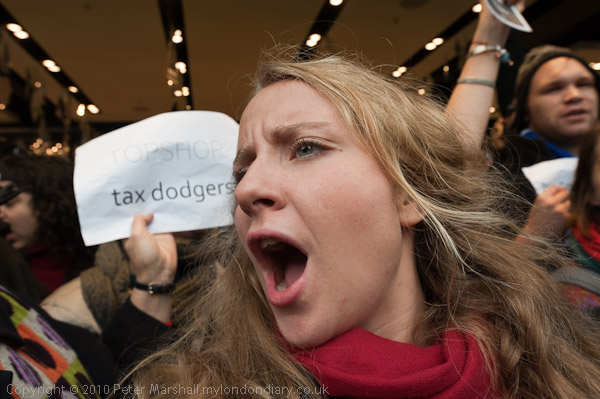 Protesters
blocked the doorway of the Oxford St store for several hours
Protesters
blocked the doorway of the Oxford St store for several hours
more pictures
Several hundred protested at Topshop and other Oxford Street stores in Philip Green's Arcadia Group, one of the major companies who together are alleged to dodge £12 billion per year in UK tax. London, UK. 04/12/2010
When I arrived at the Oxford Street branch of Topshop, there were around a hundred demonstrators in the shop, with the store security blocking the entrances. The protest was organised by UK Uncut, and was against the man they call "Britain’s most notorious tax-avoider, Sir Philip Green, and his vast retail empire."
Greens brands include Topshop, Topman, Dorothy Perkins, Burton, Miss Selfridge Wallis and British Home Stores. While Green himself pays tax on his salary, the companies are owned by a holding company in the tax haven of Jersey, which is owned by his wife and immediate famiily who live in Monaco, and pay no tax.
UK Uncut say that when Green awarded himself a huge dividend payout - £1.2 billion - in 2005, it went through various offshore accounts and tax dodges to his wife's Monaco bank account. The loss in tax to the UK was £285 million, and the arrangements used for this payment are still in place.
In August, Green was appointed by David Cameron to advise the government on how to slash public spending. As UK Uncut point out, if Green and other companies and hugely rich people were forced to pay tax in the UK like the rest of us, few if any of these cuts would be needed. It is estimated that the annual loss is £ 13 billion from rich individuals and £12 bilion by large corportations. Other companies being targetted by UK Uncut for high levels of tax avoidance include Vodaphone, Boots, HSBC and Barclays.
But the Con-Dem government has actually announced a 15% cut in the HM Revnue and Customs budget, which will greatly affect their ability to investigate tax fraud. At the moment every pound spent investigating tax fraud brings in an average of £60 in reclaimed tax.
UK Uncut are taking up David Cameron's idea of the Big Society, and are setting up their own 'Big Society Revenue & Customs' BSRC to help out HMR&C in chasing tax avoiders, as well as concentrating public attention on the problem through days of action such as this, where protests were taking place today or next week outside branches of Topshop and other tax avoiders in around 25 towns and cities across the UK.
At first the store security brought out the protesters from the store in ones and twos, some being manhandled rather roughly, but after around half an hour there was another brief incursion after which most or all of them left the store and joined the protest that was continuing outside the two main entrances on Oxford St.
Police helped security keep protesters outside the store, while allowing the protest to continue on the pavement, and trying to keep a path clear for shoppers walking along Oxford Street. Many of those who took leaflets clearly sympathised with the protesters demand that businesses should pay tax, and only a few people entered the store to shop when it was possible to do so.
After fairly effectively bringing business to a halt at Topshop for over and hour - and the neighbouring Mis seSelfridge, the protesters walked away for a brief protest against another of Green's Oxford Street stores, BHS, before returning to protest outside Topshop again.
Later they also visited a Dorothy Perkins - which was closed before they got there, as well as branches of two other companies accused of tax avoidance, Boots and Vodafone.
I left the protest at around 12.30, an hour and a half after its start, and returned a couple of hours later to find it continuing, with around 50 people now sitting on the pavement outside one of the entrances, and a larger group milling around outside the other.
top of page
All pictures on this section of the site are Copyright © Peter Marshall 2010; to buy prints or for permission to reproduce pictures or to comment on this site, or for any other questions, contact me.

